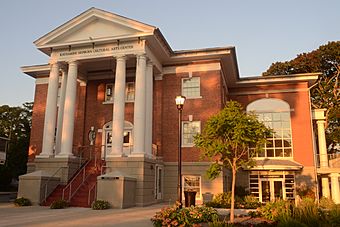Katharine Hepburn Cultural Arts Center facts for kids
Quick facts for kids |
|
|
Old Saybrook Town Hall and Theater
|
|

The Katharine Hepburn Cultural Arts Center in 2011
|
|
| Location | 300 Main St., Old Saybrook, Connecticut |
|---|---|
| Area | 1 acre (0.40 ha) |
| Built | 1910–11 |
| Built by | William L. Roe Jr. |
| Architect | James Sweeney |
| Architectural style | Colonial Revival |
| NRHP reference No. | 07000558 |
| Added to NRHP | June 21, 2007 |
The Katharine Hepburn Cultural Arts Center, often called The Kate, is a cool place in Old Saybrook, Connecticut. It's a performing arts center that opened in 2009. It's named after Katharine Hepburn, a famous actress who won many awards and lived in Old Saybrook for a long time.
About The Kate
The Kate is a special non-profit organization that brings arts to the community. It's located in a historic building that used to be the town hall and a theater. This building first opened way back in 1911! In 2007, it was added to the National Register of Historic Places. This means it's an important historical site.
The building was updated using money from the Town of Old Saybrook and donations. Now, it has a theater with 285 seats. It also has the Katharine Hepburn Museum. Each year, The Kate hosts over 250 shows and events. These include music, plays, comedy, movies, and dance. They even show live opera performances! The Kate also has art classes for kids and teens.
The Katharine Hepburn Museum
The Katharine Hepburn Museum is a fun place to learn about her life. It has many photos from her acting career and personal life. You can see her Primetime Emmy Award from 1975. There are also letters she wrote to her family when she was starting out. The museum displays some of her costumes and personal clothes. You can even see two of her paintings, including a picture she painted of herself!
Building History and Design
The building was designed by an architect named James Sweeney from New London. He created it in the "Colonial Revival Style." This style looks back to the architecture of early American homes. The main builder for the project was William L. Roe Jr., also from New London. The building was finished between 1910 and 1911.
See also



